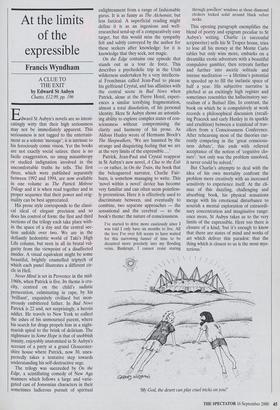At the limits of the expressible
Francis Wyndham
A CLUE TO THE EXIT by Edward St Aubyn Chatto, £12.99, pp. 196 Edward St Aubyn's novels are so intoxi- catingly witty that their high seriousness may not be immediately apparent. This seriousness is not tagged to the entertain- ment as a solemn 'message': it is intrinsic to his ferociously comic vision. Yet the books are not exactly social satires: there is no facile exaggeration, no smug misanthropy or studied indignation involved in the uncomfortable truths he tells. The first three, which were published separately between 1992 and 1994, are now available in one volume as The Patrick Melrose Trilogy and it is when read together and in proper sequence that their power and orig- inality can be best appreciated.
His prose style corresponds to the classi- cal ideal of elegant precision and so does his control of form: the first and third sections of the trilogy each take place with- in the space of a day and the central sec- tion unfolds over two. We are in the defiantly hedonistic world of Taki's High Life column, but seen in all its brutal vul- garity from the viewpoint of a disaffected insider. A visual equivalent might be some beautiful, brightly enamelled triptych of which each panel illustrates a different cir- cle in Hell.
Never Mind is set in Provence in the mid- 1960s, when Patrick is five. Its theme is cru- elty, centred on the child's sadistic persecution, culminating in rape, by his `brilliant', exquisitely civilised but mon- strously embittered father. In Bad News Patrick is 22 and, not surprisingly, a heroin addict. He travels to New York to collect the ashes of his unmourned parent, where his search for drugs propels him in a night- marish spiral to the brink of delirium. The nightmare in Some Hope is that of snobbish inanity, enjoyably anatomised in St Aubyn's account of a party at a grand Gloucester- shire house where Patrick, now 30, unex- pectedly takes a tentative step towards understanding his self-destructive urge.
The trilogy was succeeded by On the Edge, a scintillating comedy of New Age manners which follows a large and varie- gated cast of Jonsonian characters in their sometimes ludicrous pursuit of spiritual enlightenment from a range of fashionable gurus. It is as funny as The Alchemist, but less farcical. A superficial reading might define it is as an ingenious and well- researched send-up of a comparatively easy target, but this would miss the sympathy felt and subtly conveyed by the author for these seekers after knowledge: for it is knowledge that they seek, not magic.
On the Edge contains one episode that stands out as a tour de force. This describes a psychedelic trip in the Utah wilderness undertaken by a very intellectu- al Frenchman called Jean-Paul to please his girlfriend Crystal, and has affinities with the central scene in Bad News when Patrick, alone at the Pierre Hotel, experi- ences a similar terrifying fragmentation, almost a total dissolution, of his personal identity. Here St Aubyn shows an astonish- ing ability to explore complex states of con- sciousness . without compromising the clarity and harmony of his prose. As Aldous Huxley wrote of Hermann Broch's The Sleepwalkers, 'We are haunted by the strange and disquieting feeling that we are at the very limits of the expressible....'
Patrick, Jean-Paul and Crystal reappear in St Aubyn's new novel, A Clue to the Exit — or rather, in On the Train, the book that the beleaguered narrator, Charlie Fair- burn, is somehow managing to write. This `novel within a novel' device has become very familiar and can often seem pointless- ly pretentious. Here it is effectively used to discriminate between, and eventually to combine, two separate approaches — the sensational and the cerebral — to the book's theme: the nature of consciousness.
I've started to drive more cautiously since I was told I only have six months to live. All the love I've ever felt seems to have waited for this narrowing funnel of time to be decanted more precisely into my flooding veins. Bankrupt, I cannot resist staring through jewellers' windows at those diamond chokers locked solid around black velvet necks.
This opening paragraph exemplifies the blend of poetry and epigram peculiar to St Aubyn's writing. Charlie (a successful scriptwriter) sells his St Tropez house, tries to lose all his money at the Monte Carlo tables but only wins more, embarks on a dreamlike erotic adventure with a beautiful compulsive gambler, then retreats further and further into ascetic solitude and intense meditation — a lifetime's potential is speeded up to fill the inelastic space of half a year. His subjective narrative is pitched at an excitingly high register and sometimes resembles the hallucinatory sur- realism of a Buiiuel film. In contrast, the book on which he is compulsively at work records a philosophical discussion (recall- ing Peacock and early Huxley in its sparkle and erudition) between a trainload of trav- ellers from a Consciousness Conference. After rehearsing most of the theories cur- rently competing in the 'great conscious- ness debate', this ends with relieved acceptance of the notion of 'cognitive clo- sure': 'not only was the problem unsolved, it never could be solved.'
But Charlie's attempts to deal with the idea of his own mortality confront the problem more creatively with an increased sensitivity to experience itself. At the cli- max of this dazzling, challenging and absorbing book, his physical sensations merge with his emotional disturbance to nourish a mental exploration of extraordi- nary concentration and imaginative range: once more, St Aubyn takes us to the very limits of the expressible. Here too there is closure of a kind; 'but it's enough to know that there are states of mind and works of art which deliver this paradox: that the thing which is closest to us is the most mys- terious.'
My God, the desert can play cruel tricks on you!'


































































 Previous page
Previous page